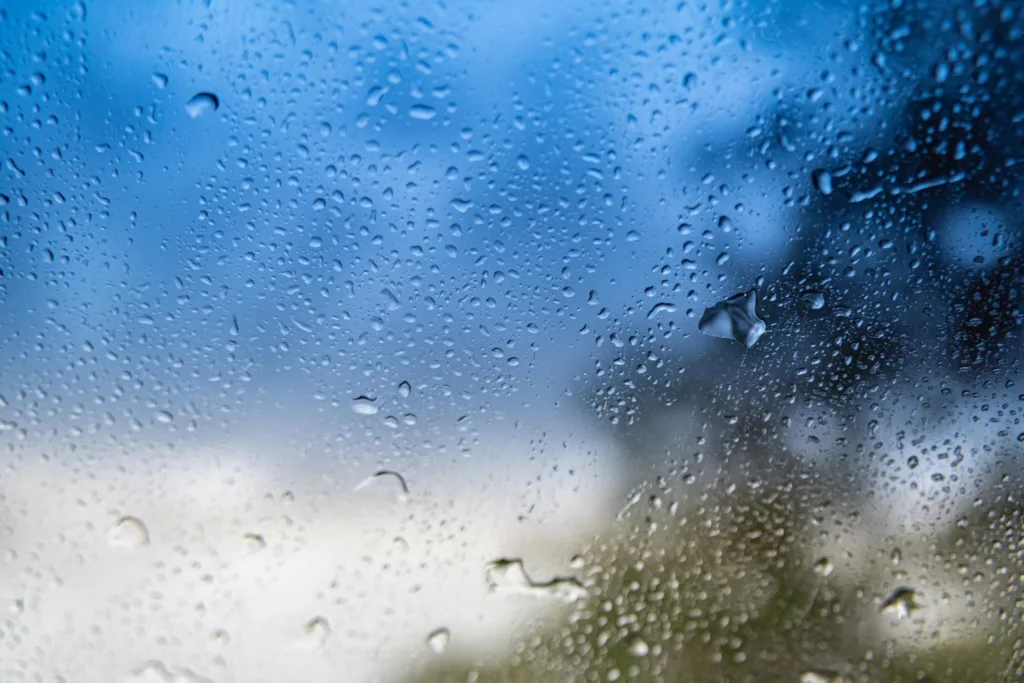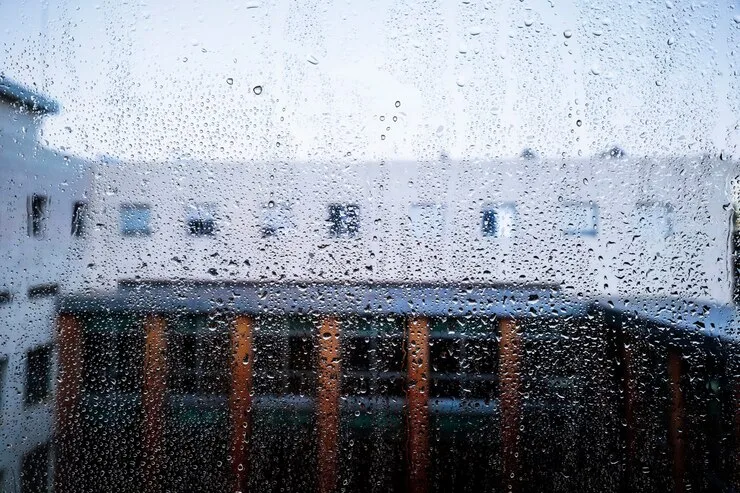
Condensation on the inside of windows is a common phenomenon that occurs when water vapor in the air comes into contact with a cold surface, such as a window pane, and condenses into liquid droplets. It is most noticeable during colder months when the temperature differential between the inside and outside of a building is significant. While it may seem like a minor inconvenience, condensation can have detrimental effects on your home if left unaddressed.
If warm, wet air touches a cooler surface, condensation will happen. When the air inside your home contains a high level of humidity, and the temperature of your windows is lower than the dew point (the temperature at which air becomes saturated and can no longer hold all its moisture), condensation forms. This can lead to water droplets accumulating on the windows, causing fogging, water stains, and even mold growth if not properly managed.
Causes of condensation on the inside of windows
Several factors can contribute to condensation on the inside of windows. Understanding these causes can help you take appropriate measures to prevent or minimize the occurrence of condensation in your home.
High indoor humidity
One of the primary causes of condensation is high humidity levels within your home. Everyday things like breathing, cooking, and taking showers all add wetness to the air. If your home is not adequately ventilated or if you have excessive moisture sources, such as indoor plants or a damp basement, the humidity levels can rise, increasing the likelihood of condensation on your windows.
Poor ventilation
Insufficient airflow and poor ventilation in your home can trap moisture indoors, leading to elevated humidity levels and increased condensation on windows. This can be particularly problematic in tightly sealed, energy-efficient homes that restrict the exchange of indoor and outdoor air.
Inadequate insulation
Another common cause of condensation is inadequate insulation around windows. When warm, moist air comes into contact with a cold window surface, the temperature difference can cause condensation to form. Properly insulated windows can help reduce this temperature differential, minimizing condensation.
Temperature differentials
Significant differences in temperature between the inside and outside of your home can contribute to condensation on windows. During the winter months, when the outdoor air is cold and the indoor air is warm, condensation is more likely to occur.
Understanding humidity levels and condensation

Humidity plays a crucial role in the formation of condensation on windows. The level of humidity in your home is determined by the amount of moisture present in the air. It is typically measured as a percentage, with higher percentages indicating higher humidity levels.
The ideal indoor humidity level for most homes is between 30% and 50%. If the humidity level is consistently above this range, condensation is more likely to occur. However, if the humidity level is too low, it can lead to discomfort, dry skin, and even respiratory issues.
To monitor humidity levels in your home, you can use a hygrometer, a device specifically designed to measure humidity. By regularly checking the humidity levels, you can take appropriate action to maintain a healthy balance and prevent excessive condensation on your windows.
The impact of condensation on your home

While condensation on the inside of windows may seem like a minor annoyance, it can have significant consequences for your home if not addressed promptly. Some of the potential impacts of condensation include:
- Water damage: Over time, the accumulation of water droplets on windows can lead to water stains, rotting window frames, and even structural damage. If the water seeps into the walls or surrounding structures, it can cause mold growth, which can be detrimental to both your health and the integrity of your home.
- Reduced energy efficiency: Condensation on windows can also affect the energy efficiency of your home. When moisture accumulates on the windows, it creates a barrier that reduces the effectiveness of insulation and increases heat loss. This can result in higher energy bills as your heating system works harder to maintain a comfortable temperature.
- Mold and mildew growth: Excessive condensation can create a favorable environment for mold and mildew growth. Mold spores thrive in damp conditions, and if left unchecked, can spread throughout your home, causing respiratory issues and allergies.
- Aesthetics: Condensation can fog up your windows, obstructing the view and diminishing the aesthetic appeal of your home. It can also lead to water streaks and stains, which can be difficult to remove and may require professional cleaning.
How to prevent condensation on the inside of windows

Preventing condensation on the inside of your windows requires a multifaceted approach that addresses the underlying causes of high humidity and temperature differentials. Here are some effective strategies to prevent condensation:
- Improve ventilation: Proper ventilation is crucial in maintaining balanced humidity levels. Ensure that your home has sufficient airflow by opening windows or using exhaust fans in areas prone to moisture, such as the kitchen and bathrooms. Installing trickle vents on your windows can also help improve ventilation without compromising security.
- Use dehumidifiers: Dehumidifiers are devices that remove excess moisture from the air, helping to maintain optimal humidity levels in your home. They are especially useful in areas with high humidity, such as basements or laundry rooms. Consider investing in a dehumidifier to reduce the likelihood of condensation on your windows.
- Insulate your windows: Proper window insulation can help reduce temperature differentials and minimize condensation. Consider adding weatherstripping or caulking around your windows to seal any gaps and prevent cold air from coming into contact with the glass.
- Monitor indoor humidity: Regularly check the humidity levels in your home using a hygrometer. If the humidity consistently exceeds the recommended range, take appropriate measures to reduce moisture sources or invest in a whole-house humidification system to regulate humidity levels.
- Avoid drying clothes indoors: Hanging wet clothes to dry indoors can significantly increase the humidity levels in your home. Whenever possible, use a dryer or hang clothes outside to dry.
Solutions for reducing condensation
In addition to preventive measures, there are several solutions that can help reduce condensation on the inside of your windows. These solutions focus on managing the immediate effects of condensation and minimizing its impact on your home:
- Wipe off condensation: Regularly wiping off condensation from your windows can help prevent water stains and reduce the likelihood of mold growth. Use a clean, dry cloth or absorbent material to gently wipe the moisture away.
- Use window insulation film: Window insulation film is a thin, transparent sheet that adheres to the inside of your windows, creating an additional barrier against cold air and reducing condensation. It is an affordable and easy-to-install solution that can be particularly effective in colder climates.
- Invest in double-glazed windows: Double-glazed windows consist of two panes of glass separated by an insulating layer of air or gas. They provide enhanced insulation and significantly reduce condensation by minimizing temperature differentials. While more expensive than single-glazed windows, they offer long-term energy savings and improved comfort.
Tips for managing moisture in your home

In addition to addressing condensation on windows, managing moisture levels throughout your home is essential in preventing other moisture-related issues. Here are some tips to help you effectively manage moisture:
- Ventilate high-moisture areas: Ensure that areas prone to high moisture, such as the kitchen and bathrooms, are adequately ventilated. Use exhaust fans or open windows to allow the moisture to escape.
- Fix leaks promptly: Address any leaks or water damage in your home promptly. Repairing leaks in pipes, roofs, or windows can prevent the accumulation of excess moisture and potential mold growth.
- Use waterproof materials: When renovating or remodeling your home, consider using waterproof materials in areas exposed to moisture, such as bathrooms and kitchens. This can help prevent water damage and reduce the likelihood of condensation.
- Monitor and maintain your HVAC system: Regularly inspect and maintain your heating, ventilation, and air conditioning (HVAC) system to ensure it is functioning optimally. A well-maintained HVAC system can help regulate humidity levels and prevent moisture-related issues.
Common misconceptions about condensation
There are several misconceptions surrounding condensation on windows. Addressing these misconceptions can help you better understand the phenomenon and take appropriate action to prevent or manage condensation:
- Condensation is a sign of faulty windows: While poorly insulated or single-glazed windows can contribute to condensation, it is not solely a result of faulty windows. Condensation is primarily caused by high humidity levels and temperature differentials.
- Opening windows eliminates condensation: While opening windows can improve ventilation and reduce humidity levels, it is not always effective in eliminating condensation entirely. In colder climates, opening windows may introduce more cold air, exacerbating the temperature differential and increasing condensation.
- Condensation only occurs in older homes: Condensation can occur in both older and newer homes. Modern, energy-efficient homes are often more airtight, which can trap moisture indoors, leading to increased condensation if not properly ventilated.
When to seek professional help for condensation issues
In most cases, condensation on the inside of windows can be managed through preventive measures and simple solutions. However, there are instances when it is advisable to seek professional help:
- Persistent mold growth: If you notice significant mold growth around your windows or elsewhere in your home, it is essential to contact a professional mold remediation specialist. They can assess the extent of the mold infestation and recommend appropriate remediation measures.
- Structural damage: If condensation has caused significant damage to your windows, frames, or surrounding structures, it may require professional repair or replacement. Contact a reputable window contractor to evaluate the extent of the damage and provide necessary repairs or replacements.
- Chronic condensation issues: If you have tried various preventive measures and solutions, but condensation continues to be a persistent problem, it may be beneficial to consult with an HVAC specialist or a building scientist. They can conduct a thorough assessment of your home’s moisture levels and recommend customized solutions to address the underlying causes of excessive condensation.
Conclusion: Maintaining a condensation-free home
Condensation on the inside of windows is a common issue that can have significant consequences if not properly addressed. By understanding the causes of condensation, monitoring humidity levels, and implementing preventive measures, you can maintain a condensation-free home.
Proper ventilation, insulation, and moisture management are key to reducing condensation and its associated problems. Regularly monitoring humidity levels, wiping off condensation, and investing in solutions such as window insulation film or double-glazed windows can help manage condensation effectively.
If you encounter persistent condensation issues, mold growth, or structural damage, it is advisable to seek professional help. Experts in mold remediation, window replacement, or building science can provide specialized knowledge and solutions tailored to your specific needs.
By taking proactive measures to prevent and manage condensation, you can ensure a healthier, more comfortable living environment and protect the integrity of your home.
Contact Rhino Window Replacement San Francisco for professional assistance and advice on managing condensation and improving the performance of your windows.